![]()
![]()
![]()
Use LEFT and RIGHT arrow keys to navigate between flashcards;
Use UP and DOWN arrow keys to flip the card;
H to show hint;
A reads text to speech;
78 Cards in this Set
- Front
- Back
- 3rd side (hint)
|
What are the primary structures of the digestive system? (7) |
Mouth/oral cavity Pharynx Oesophagus Stomach Small Intestine Large Intestine Rectum and Anus |
|
|
|
What are the accessory organs of the digestive system? (4) |
Salivary glands Liver Pancreas Gallbladder |
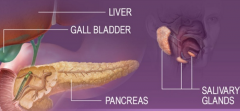
|
|
|
What are the six processes of the digestive system? |
1. Ingestion 2. Mechanical processing 3. Chemical digestion 4. Secretion 5. Absorption 6. Excretion |
|
|
|
When does ingestion occur? What muscles does it involve? What process is this in digestion? (#) |
Occurs when materials enter the digestive tract via the mouth. Voluntary skeletal muscles. #1 |

|
|
|
What does mechanical processing involve? (1) What does it make? (1) What process is this in digestion? (#) |
- Crushing and shearing (in the mouth) for smaller particles - Makes materials easier to propel along digestive tracts (moulding of food to fit in the tract) |
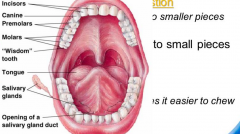
|
|
|
1. What does chemical digestion involve? 2. What type of process is this? 3. What process is this in digestion? (#) |
1. The chemical breakdown of food into small organic fragments for absorption by digestive epithelium 2. Molecular process 3. #3 |
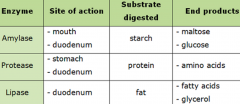
|
|
|
1. What does the secretion process involve the release of? 2. Where is this released? 3. What # process is this in digestion? |
1. The release of water, acids, enzymes, buffers and salts (bile) 2. By epithelium of digestive tract and glandular organs 3. #4 |
|
|
|
1. What does the absorption process move? What does this move across? 2. What # process is this in digestion? |
1. Movement of organic substrates, electrolytes, vitamins and water. Across digestive epithelium into interstitial fluid of the digestive tract. 2. #5 |
|
|
|
What does the excretion process involve? What # process is this in digestion? |
Removal of waste products. Defecation. #6 |
|
|
|
What are the key functions of the mouth/oral cavity? (5) |
1. Ingestion 2. Sensory analysis (PTC in kale) 3. Lubrication 4. Mechanical processing. 5. Initiates chemical digestion. |
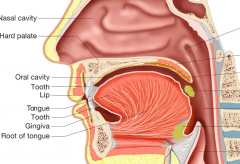
|
|
|
1. What is the pharynx? 2. What type of processing is this? 3. Which three parts exists here? Top down. 4. What do the muscles do? |
1. A common pathway for solid foods, liquids and air. 2. Mechanical processing (#2). 3. Oropharynx, laryngopharynx, oesophagus 4. Force the boulas down during swallowing. |
|
|
|
What is the fancy word for swallowing? |
Deglutition. |
|
|
|
What is the oesophagus like in shape and size? What is it lined with? |
25-30cm long Lined with stratified squamous epithelium |
|
|
|
1. What is the oesophagus NOT involved with? 2. What processing is it involved in? 3. What moves from where to where, and via what mechanism? |
1. No digestion/absorption. 2. Mechanical processing. 3. Boulas moves from pharynx to stomach via peristalsis. |
|
|
|
What is peristalsis? |
A series of wave-like muscle contractions that moves food to different processing stations in the digestive tract. |
|
|
|
1. What is the stomach shaped like? 2. What is the size? |
1. J-shaped. 2. 50mL to 1-1.5L depending on when you've eaten |
|
|
|
What are the key functions of the stomach? (4) |
1. Mechanical processing. 2. Chemical digestion. 3. Absorption. 4. Storage of food. |
|
|
|
What does mechanical processing in the stomach involve? |
Continued peristalsis mixes food boulas with chemicals (enzymes) to become chyme |
|
|
|
Where does 95% of the absorption happen in the digestion system? |
Small intestine. |
|
|
|
What are the key functions of the small intestine? (3) |
1. Mechanical digestion via peristalsis & segmentation 2. Chemical digestion (carbohydrate digestion, protein digestion, lipid digestion) 3. Absorption of nutrients. |
|
|
|
What are the four parts of the large intestine? (4) |
1. Large bowel 2. Cecum 3. Colon 4. Rectum |
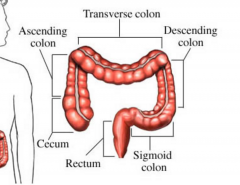
|
|
|
What are the key functions of the large intestine? (3) |
1. Reabsorption 2. Absorption 3. Compaction and storage of fecal material prior to defecation |
|
|
|
What does the large intestine to reabsorb? (2) |
Water Bile salts (transported in blood to liver) |
|
|
|
What does the large intestine absorb? (4) |
1. Nutrients (10%) 2. Minerals, short-chain fatty acids 3. Vitamins produced by bacteria e.g. vitamin K 4. Organic wastes |
|
|
|
What are the eight essential nutrients? |
Carbohydrates Proteins Lipids Vitamins Minerals Electrolytes Fibre Water |
|
|
|
Where does Vitamin K come from?
|
We have a symbiotic relationship with flora in out large intestine. Vitamin K is a cellular byproduct they produce when breaking down cellulose. |
|
|
|
1) How does the digestion system handle each nutrient? 2) How must large organic molecules be broken down? 3) How must water, electrolytes & vitamins be processed? |
1) Differently 2) Must be digested before absorption can occur. 3) Can be absorbed without processing, may require special transport. |
|
|
|
1) What constitutes a large organic molecule? 2) How are these processed? |
1) Carbohydrates, lipids, protein, nucleic acid 2) Must be digested before absorption can occur. |
|
|
|
1) What are digestive enzymes? 2) What do they do? 3) Where do they act? 4) What do they act in (3)? |
1) Proteins that help catalyse chemical reactions. 2) Break down molecular bonds in large organic molecules 3) Outside cells in the lumen 4) Mouth, stomach, S.I |
|
|
|
What are digestive enzymes secreted by? (5) |
1. Salivary glands 2. Tongue 3. Stomach 4. Pancreas 5. Intestinal microvilli (endothelial layer) |
|
|
|
1. What does absorption remove? 2. What only is absorbed? 3. What does it go across? 4. & into what? |
1. Organic substrates, electrolytes, vitamins and water 2. Simple molecules. 3. Digestive epithelium. 4. Into interstitial fluid of digestive tract |
|
|
|
What breaks down starch? Into what? Which liquid? |
Amylase into Maltose Saliva |
|
|
|
What breaks down proteins? (2) Into what? from what juice?? |
Protease/Pepsin & Hydrochloric acid into Partly digested proteins in the gastric juice |
|
|
|
What breaks down proteins, only via assistance of the pancreas? Into what? |
Proteases (trypsin) into peptides & amino acids |
|
|
|
What breaks down peptides? Into what? (4) What type of enzyme? |
Peptidases Amino acids Intestinal enzymes |
|
|
|
What breaks down fats emulsified by bile? Into what? From which substance? |
Lipases Fatty acids and glycerol Pancreatic juices |
|
|
|
What breaks down starch, with assistance from pancreatic juices? |
Amylase, into maltose. This is also the same as the saliva. |
|
|
|
What breaks down peptides, into what? - Intestinal enzymes |
Peptidases into amino acids |
|
|
|
What breaks down sucrose? Into what? What substances? |
Sucrase into glucose and fructose Intestinal enzymes |
|
|
|
What breaks down lactose? Into what? What substances? |
Lactase Into glucose and galactose Intestinal enzymes |
|
|
|
What breaks down Maltose? Into what? What substance? |
Maltase into glucose Intestinal enzymes |
|
|
|
- In absorption, where do substances move? (2) - What moves into either category? |
- Into the blood or lymphatic system - Blood: Monosaccharides & amino acids via the hepatic portal system. Lymphatics: fatty acids & monogylcerides |
|
|
|
What are monosaccharides? |
Carbohydrates. |
|
|
|
Where does the hepatic portal system go to and from? |
To liver from GI tract. |
|
|
|
How are things transported across membranes in the digestive systems? (2) Which is passive, which is active. |
Diffusion. PASSIVE. Carrier-mediated transport. ACTIVE. |
|
|
|
What is carrier-mediated transport? |
Compounds bind to integral protein for transport across membrane. |
|
|
|
What are the (3) kinds of carrier-mediated transport? |
1. Facilitated diffusion 2. Active transport 2. Cotransport |
|
|
|
What is facilitated diffusion? Is ATP required? |
- Channels or carrier proteins passively transport one solute down a concentration gradient - ATP not required |
|
|
|
What is active transport? What is up with concentration gradients? Is ATP required? |
Carrier proteins actively transport solutes. Not dependent on concentration gradients. Consumes ATP. |
|
|
|
What is cotransport? Is ATP required? |
Carrier proteins move two solutes in the same direction ATP might be required |
|
|
|
What are the (3) ways water moves across the lining of the digestive tract? AKA? |
1. Passive water flow 2. Down osmotic gradient 3. To area of high solute concentration & low water concentration AKA= water follows nutrients into cells/interstitial fluid |
|
|
|
1. Where does most of the bodies water come from? 2. Where is most reabosorbed? 3. Where is the remainder absorbed? |
1. Not from your diet. mostly from digestive secretion. 2. Small intestine 3. Large intestine, to compact feces |
|
|
|
What ions must be regulated for homeostasis? (5) |
Sodium, Potassium, Calcium, Iron, Magnesium |
|
|
|
How is sodium transported in digestion? |
Channel mediated diffusion, cotransport & active transport |
|
|
|
How is potassium transported in digestion? |
Channel mediated diffusion |
|
|
|
How is calcium, iron and magnesium transported in digestion? |
Active transport |
|
|
|
What are vitamin compounds? |
Organic compounds required in small quantities |
|
|
|
What vitamins are fat soluble? What is the transport mechanism? What are the regulatory factors? |
A, D, E, K Diffusion Absorbed along with fats, can be stored in liver |
|
|
|
What vitamins are water soluble and transported by channel mediated diffusion? What are the regulatory factors? |
C, D Follows concentration gradient Not stored, excess excreted in urine |
|
|
|
What vitamins are water soluble and transported by active transport? What are the regulatory factors? |
B12 Must be bound to intrinsic factor |
|
|
|
What are the 4 layers of the digestive tract? Inner to outer. |
Mucosa Submucosa Muscularis external (peristalsis) Serosa (some, not all GI tract) |
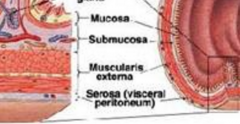
|
|
|
What is the inner layer of the GI tract called? 2) What is it made of? 3) What is an element/layer within that is special? |
1) Mucosa 2) Mainly epithelial tissue 3) Muscularis mucosae (band of smooth muscles & elastic fibers) |
|
|
|
What is the role of the mucosa? (3) |
1. Absorption 2. Secretion of mucus, enzymes & hormones 3. Protection - lymphoid tissues |
|
|
|
Where is there stratified squamous epithelium in the GI tract? Why? |
Oral cavity, pharynx, oesophagus Mechanical stresses. |
|
|
|
Where is there simple columnar epithelium in the GI tract? Why? |
Stomach, small intestine, large intestine |
|
|
|
1) Where does the submucosa lie? 2) What is it? |
1) Beneath the mucosa 2) Dense, irregular connective tissue |
|
|
|
What lies in the submucosa? (5) |
1. Blood & lymph vessels 2. Lymphatic nodules 3. Glands (buffers & enzymes) 4. Nerves, receptors 5. Sensory neurons |

|
|
|
1) What is the main component of the muscularis externa? 2) What are the 2 layers? 3) What is the outer layer do? (2) 4) What does the inner layer do? (2) |
1) Dominated by smooth muscle cells. 2) Outer longitudinal muscle layer, inner circular musc. layer 3) A) Mechanical processing B) Peristalsis. 4) Agitation. Form valves. |
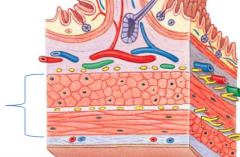
|
|
|
1. What is the serosa? 2. What is it made of? 3. Where is it absent in the GI tract? 4. What is its role? |
1. Serous membrane covering muscularis externa. 2. Connective and epithelial tissue. 3. Not in oral cavity, pharynx, oesophagus & rectum 4. Protection |
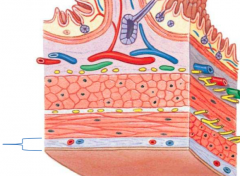
|
|
|
What 3 elements control digestion? |
1. Enteric nervous system 2. Local and systemic control 3. Endocrine system |
|
|
|
What is influenced by the ENS? |
Motility, secretion and growth |
|
|
|
1. What is the enteric nervous system? 2. What can it do, and what is this called? |
1. 3rd division of the ANS, a network of neurons int he walls of the DT 2. Can carry out a response without input from the CNS. AKA short reflexes. (Reflexes integrated in CNS are long reflexes) |
|
|
|
What are short reflexes? |
Intrinsic neurons = completely within ENS i.e walls of gut |
|
|
|
What are long reflexes? |
Extrinsic neurons = bring signals from CNS to the digestive system. |
|
|
|
1. When is the defecation reflex stimulated? 2. What process # is this? 3. What two reflexes does it involve? |
1. When the rectum is stretched 2. #6 3. The intrinsic & parasympathetic defecation reflexes? |
|
|
|
1. Where does the intrinsic defecation reflex operate? 2. When is it stimulated? 3. What does it innervate? |
1. Entirely within the myenteric plexus - does not need the CNS! 2. Stimulated when the walls of the colon are stretched 3. Weak peristaltic movements, relaxation of the internal sphincter |
This is an example of positive feedback. |
|
|
1. When is the parasympathetic defecation reflex innervated? 2. What is its response? |
1. Stretch in colon sends signals to spinal cords 2. Response: intensifies peristalsis & relax internal sphincter |
This is an example of positive feedback. |
|
|
What hormone is released in the small intestine first? What does it do? |
GIP, which stimulates the release of insulin from the pancreas |
|

